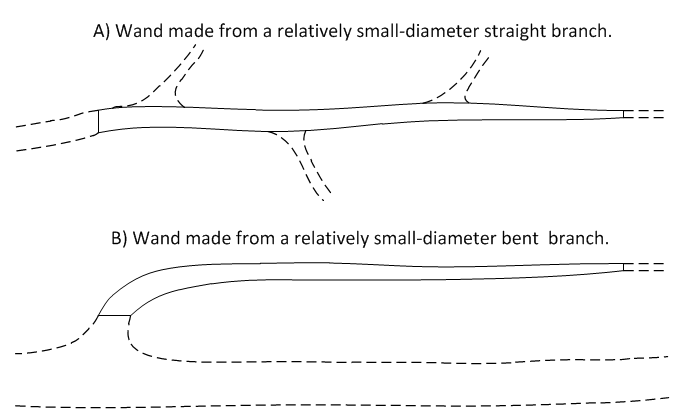


|
| Tweet |
|
|
|
|
 |
 |
|
|
 On this page, you can read about the parts and components of magic wands as described in the book Magical Wands - A Cornucopia of Wand Lore: The Parts of a Magic WandThe first thing to learn about magic wands is their composition. As illustrated below, most wands are composed of the following five basic parts: the end cap, the handle, the shaft, the tip, and most importantly the core, which is buried inside of the handle and shaft. 
Illustration 1: The Five Parts of a Complete Wand Every wand need not have all five of these parts. For example, simpler wands typically have neither a separate end cap nor tip. In the simplest wands, there is also no distinction between the handle and the shaft, and the wand is composed of a single piece of wood, often a small branch from a tree or bush. Thus, the only two essential parts of a wand are the shaft (usually composed of wood) and the core, which contains a part of a magical creature. 
Illustration 2: The Two Parts of a Simple Wand Wand ComponentsTraditionally, wands are made of the following four types of materials:
There is a fundamental difference between the terms magical and mystical. The magical components of wands are derived from living organisms: creatures and trees. They retain some of the magic these organisms had while alive. Magical components strengthen the spells cast with the wand. On the other hand, the mystical components of wands were never alive (with the notable exception of amber, which is fossilized tree sap and has been so greatly modified from its original form over many thousands or even millions of years that none of the original magic remains). Mystical components focus the spells cast with the wand. Most wands have some form of ornamentation. The handle is often carved with small grooves and ridges along its circumference. The shaft can have its own carvings, often runes but sometimes also plants such as grape vines. Another common ornamentation is to have the shaft carved with spiral grooves so that it forms a narrow corkscrew. Finally, although the handle and shaft are usually connected in a straight line, some wands are bent where the shaft meets the handle. Even though this breaks the symmetry of the wand, some mages find it easier to aim the shaft of a bent wand at the targets of the spells. All of these variations are primarily ornamental, as the actual shape of the wand has little or no impact on the power of the spells strengthened or focused by the wand. The shape of a wand is mainly a matter of individual taste. More important are the amount of wood and the length of the wand. More wood minorly increases the strength of the spells, and a longer wand makes it easier to aim the spells. Of course, long wands can easily become unwieldy and difficult to carry. Sometimes, it is also important to have a small wand that is easier to hide from mundane eyes. Complex WandsThe following is an example of a relatively complex phoenix wand. The wand maker has crafted a harmonious wand because all of its components are compatible, sharing same elemental (Fire) and phase (Light). This includes the magical creature (phoenix), a feather of which is in the wand’s core, the magical woods (cherry and maple) that form the wand’s handle and shaft, the mystical crystals (citrine, diamond, and ruby), and the mystical metal (gold). This wand is therefore a very powerful wand for casting Light fire spells. 
Illustration 3: A Relatively Complex yet Harmonious Wand Wand makers have an immense number of possible choices when selecting the materials for a wand. There are 14 mystical creatures commonly used in wand making and since different parts of these creatures are used, the wand maker has 30 options for the contents of the core. There are 21 different types of woods commonly used to make wands, and since wands typically use either one or two woods, that gives 441 different options for the handle and shaft wand makers can choose. There are even more possibilities when one factors in all of the less common and downright unusual wands that can and have been made. Thus, the majority of wands do not have the same components as other wands because there are so many possibilities available to the wand maker. Traditional Wands Made from BranchesAnother way to categorize wands is by the part of the tree that supplies the wood. Originally, all wands were made from relatively small-diameter branches that were reasonably straight at the tip. The size of such wands enabled them to fit naturally in mages’ hands and be easily pointed at the subjects of spells. As depicted in illustration 4, wands made from branches come in two basic forms: (A) relatively straight branches with minor bends due to the existence of smaller side branches and (B) branches that have a significant curve at the large end where they branched off of larger branches. Not long afterwards, wand makers began to carve wands out of bigger, thicker blocks of wood, typically cut from the trunk of the tree. Finally with the invention of the wood lathe, wand makers would turn straight blocks of wood to produce perfectly straight and round wands (see illustrations 1 and 2). 
Illustration 4: Wands Made from Small Branches |